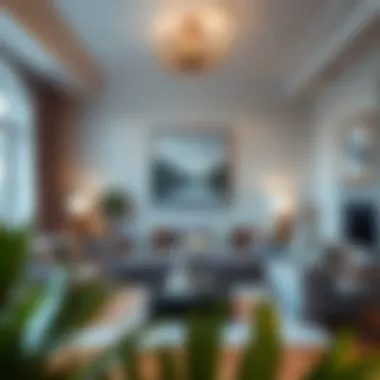A Comprehensive Guide to Room Decoration Sets


Intro
In the realm of interior design, the notion of room decoration sets has evolved into more than just a trend; it's a comprehensive approach that melds aesthetics with functionality. Homeowners, seasoned decorators, and architects continuously seek ways to enhance their spaces, making educated decisions on how to curate their environments. This guide digs into the intricacies surrounding room decoration sets, shedding light on the vital ingredients that contribute to an inviting and stylish atmosphere.
Those who venture into the world of home decor often find themselves inundated with choices—various color schemes, textures, and furniture styles—making it crucial to sift through the noise. When one understands the components of decoration sets, it becomes clearer how to weave a narrative throughout a space. Choosing the right hues can evoke feelings of warmth or vibrancy, while textures can add depth and character. The article is guest to shopping that sweet spot between practicality and design, giving you the tools to create harmonious living areas that reflect personal taste.
For homeowners and professionals alike, grasping these concepts can spark inspiration for DIY projects or the perfect professional embarkation. Moreover, as trends come and go, having a firm grasp of timeless practices ensures that your spaces will age gracefully and remain relevant. So, let’s roll up our sleeves and explore the depth of room decoration sets—where the mundane transforms into the magnificent.
Understanding Room Decoration Sets
Room decoration sets play a pivotal role in crafting a living environment that not only reflects personal style but also serves functional needs. The importance of this topic lies in the multifaceted benefits and considerations that go hand-in-hand with choosing the right elements for your space. It’s about establishing a congruous look while ensuring that every piece serves a purpose.
Definition of Room Decoration Sets
At their core, room decoration sets are collections of coordinated items designed to elevate the aesthetic appeal and functionality of a room. These sets typically include a combination of furniture, textiles, and decorative accessories that work together harmoniously. Rather than haphazardly piecing together different elements, a room decoration set offers a curated selection.
For instance, imagine a modern dining set that combines a sleek dining table with chairs that carry the same design ethos. This pairing doesn’t just serve a utilitarian purpose; it transforms the dining area into a focal point of the home. Ultimately, the definition transcends mere coordination – it encapsulates the idea of creating a cohesive narrative through your decor choices that speaks to your taste and lifestyle.
Purpose and Benefits
The purpose of room decoration sets is multifaceted, covering both aesthetic enhancement and practical utility. The myriad benefits include:
- Cohesion: By utilizing a decoration set, one can avoid the chaotic look that often arises from mismatched items. A set provides a unified look that brings balance and tranquility to a space.
- Time Efficiency: Sifting through countless options in furniture stores or online can be overwhelming. Room decoration sets streamline the decision-making process, saving time and effort.
- Guidance: These sets often reflect current trends and offer inspiration. They can guide homeowners, interior designers, and retailers in choosing items that not only compliment each other but also facilitate a cohesive environment.
"Choosing the right room decoration set can feel like putting together a puzzle; each piece must fit perfectly to complete the whole picture."
- Increased Value: A well-decorated space can increase the overall value of a property. When prospective buyers see a home with a consistent and inviting decor style, they are more likely to view it positively.
- Personal Expression: Finally, these sets afford individuals the opportunity to express their unique tastes and personalities through their choice of style, color, and theme. Whether leaning towards modern minimalism or rustic farmhouse charm, sets can encapsulate the essence of your vision.
In summary, understanding room decoration sets enables a deeper appreciation for the art of interior design. Their thoughtful arrangement and selection are essential in creating spaces that are not only functional but also captivating.
Key Components of Room Decoration Sets
Understanding the key components of room decoration sets is essential for anyone looking to enhance their living space. Each element plays a vital role in creating an environment that reflects personal taste while also serving functional purposes. These components can be broadly categorized into furniture, textiles and fabrics, as well as decorative accessories. Knowing how to balance these elements can make the difference between a cluttered room and a harmonious living area.
Furniture
Types of Furniture
Furniture acts as the backbone of any room's design. When selecting types of furniture, it’s crucial to look beyond just aesthetics. For instance, sofas, chairs, tables, and cabinets each serve their distinct purpose but also contribute to the overall vibe of the room. A well-chosen sofa, for instance, can become a focal point, inviting relaxation and conversation.
- Key Characteristic: Durability is a prime consideration in furniture selection. Depending on the material, certain types can outlast others. A hardwood dining table, for example, stands the test of time better than a plastic one.
- Unique Feature: Many modern designs incorporate multifunctional aspects, such as coffee tables with hidden storage or sofas that convert into beds. This quality is particularly beneficial for those living in smaller spaces.
However, a downside might involve the price; intricate designs and solid materials often command a higher price tag, demanding a careful selection process.
Selecting Functional Pieces
It’s easy to get carried away with aesthetics, but selecting functional pieces is crucial in any room decoration set. They should not only look good but also meet the day-to-day needs of the residents.
- Key Characteristic: Versatility defines functional pieces. A storage ottoman, for instance, serves as both seating and a place to stow away items, helping to maintain order in a busy room.
- Unique Feature: Items such as extendable dining tables provide options for different occasions, accommodating both intimate dinners and larger gatherings.
The challenge lies in the balance; while functional pieces tend to be more practical, they shouldn't completely sacrifice style. This makes choosing them both exciting and daunting.
Textiles and Fabrics
Curtains and Drapery
Curtains and drapery play a considerable role in adding softness and warmth to a space. They aren't merely functional, blocking out light and providing privacy; they also serve as an essential design element that can enhance or detract from a room's aesthetic.
- Key Characteristic: The material and thickness of curtains affect light entry and shade, therefore influencing mood. Lightweight sheers can create an airy feel, whereas heavier fabrics lend a sense of drama.
- Unique Feature: Patterns and colors in curtains allow for expression of personality, serving as a visual centerpiece or subtle accent.
Still, it’s essential to consider maintenance. While some fabrics are easy to clean, others, like silk, demand more care and can fade over time.
Upholstery Choices


Choosing upholstery is about more than just color or pattern; it can significantly affect the tactile experience of the space. Seating that is upholstered well can offer comfort and lend a tailored appearance to a room.
- Key Characteristic: Durability and ease of cleaning are paramount in seating upholstery, particularly in high-use areas. Fabrics such as leather or performance textiles are often recommended due to their ability to withstand wear and tear.
- Unique Feature: Incorporating textures through upholstery can add dimension. A combination of fabrics like velvets, linens, or canvas can bring a rich, layered look to furniture.
However, consumers must balance the benefits of aesthetic appeal with functionality. A stunning piece might lack comfort if not chosen wisely.
Decorative Accessories
Artwork
Artwork can change the entire atmosphere of a room, serving as a platform for personal expression. It can draw the eye, spark conversation, and even provide emotional comfort.
- Key Characteristic: Size matters with artwork. A large painting can create an impressive focal point, but smaller pieces work well as part of a gallery wall or series.
- Unique Feature: Original pieces or local artists can imbue a home with character, making it feel unique rather than generic.
Yet potential buyers should consider investment value. Quality artwork can be expensive but may appreciate over time.
Ornamentation
Ornamentation includes a range of decorative items such as vases, sculptures, or even books. These elements serve not just as decor but also as opportunities for storytelling and personal touch.
- Key Characteristic: Versatile and often inexpensive, ornamentation can be easily updated, ensuring that the room never feels stagnant.
- Unique Feature: Personalized items like travel souvenirs showcase personal journeys and add layers of meaning to the space.
But one must tread carefully; too much ornamentation can lead to visual clutter, detracting from the room's intended design.
Establishing a Cohesive Theme
Creating a cohesive theme is like setting the stage for a well-rehearsed play. Every element—from the furniture to the accent pieces—should harmonize, ensuring your space tells a consistent story. When the theme resonates throughout a room, it feels purposeful and expresses a unique identity.
The beauty of establishing a cohesive theme lies in its ability to create a seamless flow. Think about how different colors evoke varying emotions. A well-thought-out design pulls together various attributes to shape how one perceives the space. For instance, a coastal-themed room adorned with sand tones, soft blues, and natural materials instantly transports you to the beach. It's not merely about aesthetics; the theme aids in crafting an atmosphere where one feels comfortable and aligned with their surroundings.
Choosing a Color Palette
The color palette is the most pivotal aspect of any room decoration set, setting the mood and influencing our emotions.
Understanding Color Psychology
Color psychology hinges on the belief that colors can significantly influence feelings and behaviors. For instance, shades of blue often impart tranquility, while vibrant reds can energize a room. Adopting color psychology benefits designers as it enables them to create specific atmospheres tailored to the intended use of the space—be it restful, invigorating, or inspiring.
One unique feature of embracing color psychology is that it can aid in decision-making. By considering how certain colors affect moods, interior decorators can provide more targeted suggestions to clients. However, it can also lead to overanalysis, where decisions may be bogged down by psychological implications, sometimes overshadowing personal taste.
Combining Muted and Bold Colors
Balancing muted and bold colors can breathe life into an otherwise stagnant space. While muted tones offer soft backgrounds, bold colors inject energy and personality into the design. This combination is often best visualized in various layers, where a neutral base is spiced up with striking accents. This interplay creates depth and interest, drawing the eye to focal points. It’s a popular choice because it enables customization—one can express both subtleness and dynamism through strategic choices.
The unique aspect of this technique lies in its versatility across design styles. A sleek mid-century modern room can integrate deep emerald greens with soft taupes, while a contemporary space could blend light grays with bright yellows. The risk, however, lies in miscalculation; if not done carefully, one can overwhelm the senses and end up with a chaotic look instead of a cohesive theme.
Incorporating Patterns and Textures
Patterns and textures are the cherry on top of a well-decorated room. They can significantly enhance the visual and tactile experience of a space.
Layering Textures
Layering textures enhances the richness of decor. Think about it: a room comprising only smooth surfaces can feel sterile. Introducing diverse textures—such as soft fabrics, woven baskets, and sleek metals—creates a sensory dialogue. This addition not only enhances visual interest but also adds comfort and warmth, making the room feel inviting.
One key characteristic of layering textures is the sensory richness that emerges. It gives depth to a space, captivating visitors as they move through different experiences. On the downside, too much diversity can lead to confusion, where the harmonization falls apart, leaving a haphazard impression.
Utilizing Patterns Effectively
Patterns weave stories within the fabric of a room. They can bring about a sense of movement or structure. For instance, geometric patterns can lend a modern vibe, while floral prints evoke softness and romance. Utilizing patterns effectively integrates harmony within a design while ensuring that the focus remains balanced.
A unique feature here is the ability to define spaces within a room. A well-placed patterned rug can anchor a seating area, while striped wallpaper might enhance verticality in a short room. The risk in pattern usage mainly lies in clashing designs. Mixing patterns without a clear scheme can create visual noise and disrupt the overall flow.
Functional Design Considerations
When it comes to creating a living space that sings, functionality often goes hand-in-hand with aesthetic appeal. Room decoration sets should not only look good but also serve practical purposes. This harmony is the essence of functional design considerations. Understanding how to balance style with utility can dramatically enhance the usability of a space. Whether it's ensuring comfort in a cozy nook or facilitating movement in a busy family room, thoughtful design can make all the difference.


Space Planning
Measuring Spaces
Measuring spaces is the foundation of any successful room decoration project. Knowing the dimensions of a room helps in selecting furniture that won't overpower, nor underwhelm the area. One key characteristic of measuring spaces is that it provides a clear understanding of how every piece will fit. In this article, pinpointing accurate measurements ensures that your chosen elements create a cohesive look without feeling cramped or sparse.
A unique feature of measuring spaces is its preventive nature. By taking the time to measure before purchasing, homeowners can avoid the headache of returning oversized items that simply don’t belong. However, neglecting this step can lead to disorganized layouts, causing traffic jams during daily activities. Thus, investing time in this detail becomes not only beneficial, but essential for a well-designed room.
Traffic Flow and Accessibility
Traffic flow and accessibility are paramount when considering the layout of any room. This aspect hinges on arranging furniture in a way that allows for smooth navigation while performing daily tasks. One key characteristic here is that a clear path makes a space feel open and inviting. In this guide, prioritizing accessibility ensures that rooms can be enjoyed fully—whether hosting guests or simply lounging about.
The unique feature of examining traffic flow involves observing how people typically move in a space. Carefully placed furniture can enhance not just the visual appeal but also the overall comfort of an area. On the flip side, poorly arranged furnishings can cause guests to bump into things or even worse, create obstacles for those with mobility challenges.
Multifunctional Furniture
Maximizing Small Spaces
Maximizing small spaces is an art and a science in the realm of interior design. This concept emphasizes the importance of choosing elements that serve more than one purpose. For an evolving design landscape where space is at a premium, exploring multifunctional furniture becomes a savvy choice.
A standout characteristic of this approach is its capacity to provide both form and function in a compact footprint. For instance, a couch that folds into a guest bed or a dining table with storage underneath can transform a small room into a versatile haven. However, while these solutions can free up valuable square footage, careful consideration is needed to balance aesthetics and functionality, as overly complex designs can sometimes detract from the overall look.
Versatile Design Solutions
Versatile design solutions stem from the idea that flexibility is key in modern living. Adopting adaptable furniture and decor allows homeowners to redesign their spaces effortlessly. This approach is not only beneficial; it actively encourages creativity and personalization within any room.
The key characteristic of versatile solutions lies in their ability to shift and adapt according to various needs. Examples include ottomans that double as coffee tables, or shelves that can transform into a workspace. The unique feature here is their contribution to a dynamic lifestyle, as these elements can be reconfigured as needed.
Yet, caution is paramount; while flexibility is fantastic, sometimes, too many options can lead to decision fatigue. Striking a balance between versatility and simplicity is essential to maintain a relaxed atmosphere.
"Design is not just what it looks like and feels like. Design is how it works." — Steve Jobs
For further information, you may check resources like Encyclopedia Britannica, as well as popular forums on Reddit about modern interior design.
Trends in Room Decoration Sets
Staying up-to-date with trends in room decoration sets is vital for anyone looking to enhance their living space. Trends not only reflect the changing tastes of society but also introduce innovative ideas that can make your home more functional and aesthetically pleasing. Understanding these trends enables designers, retailers, and homeowners to adapt and evolve their interior design approaches, ensuring that the spaces they create remain relevant and engaging.
As interiors evolve, new materials, styles, and practices take center stage. By doing so, one not only enriches their own environment but also aligns with broader movements towards sustainability and improved quality of life.
Sustainable Design Practices
Eco-friendly Materials
The use of eco-friendly materials is no longer just a niche preference; it's become a hallmark of thoughtful design. These materials, often sourced from renewable resources, reduce the overall environmental impact of decorating. For instance, bamboo or reclaimed wood is gaining traction, as they embody both style and sustainability. People are increasingly drawn to these choices because they resonate with a desire for responsible living.
Key characteristic: Eco-friendly materials often exhibit natural textures and colors that can add warmth to any space. This unique attribute doesn't just contribute aesthetically but also intellectually stimulates conversations about sustainability in design.
However, the challenge lies in finding these materials within budget constraints, which can be a hurdle for some developers and homeowners alike.
Recycling and Upcycling
Recycling and upcycling are shaking up traditional ways of acquiring home decor. This trend allows individuals to breathe new life into items that might otherwise end up in landfills. Key characteristic: Upcycled pieces often carry a unique story, lending character and personal touch to a space. This individuality is why many homeowners find the notion appealing. However, one must navigate the fine line between creativity and practicality; sometimes, not all upcyled items will align with a cohesive design vision. Still, the excitement of transforming forgotten items into focal points makes this approach increasingly popular.
Emerging Styles
Minimalism
Minimalism has carved out a firm spot in today’s design landscape. By focusing on fewer items, it promotes simplicity and elegance. Key characteristic: This style often prioritizes open spaces, natural light, and an uncluttered environment, making it a preferred choice for urban dwellers. Large furniture pieces can feel intimidating amid vast empty spaces, while smaller decorative items engender an airy ambiance.
However, one must consider that pure minimalism might not suit everyone's taste. Some may feel too stripped-back and lacking warmth, which leads to the notion that a bit of layering or texture could save the day.
Biophilic Design
Biophilic design refers to integrating elements of nature into the built environment. This might involve the use of plants, natural materials, or even views of green spaces. Key characteristic: It fosters a connection to nature, which is shown to enhance well-being and reduce stress. The perceived advantage of this trend is its ability to craft indoor spaces that resonate with the outdoor world. Nonetheless, incorporating biophilic elements requires careful planning; not everyone's space allows for significant greenery or natural features, which can pose a logistical challenge for some.
The key to successful room decoration lies not just in choosing the right elements but in understanding how they fit together in modern contexts.
Whether it’s through sustainable practices or emerging styles, it’s essential to remain fluid and open to change. Each trend holds potential to not only elevate spaces but also enhance the quality of life for those that inhabit them.
DIY Room Decoration Sets


Creating your own room decoration sets is more than just a trend: it’s a form of artistic expression, a statement of individuality that can transform a drab space into something that feels distinctly yours. DIY room decoration empowers homeowners and designers alike to curate environments that reflect personal tastes and lifestyles. With the right tools and a dash of creativity, anyone can turn a vision into reality.
Crafting Your Own Design
Finding Inspiration
Finding inspiration is the first step to embarking on a DIY decor journey. It's the spark that ignites creativity and helps to cultivate a unique space. Whether you’re flipping through home magazines, scrolling on social media, or wandering through local flea markets, inspiration can strike from anywhere.
A key characteristic of finding inspiration lies in its ability to broaden one’s perspective. It encourages exploration beyond conventional ideas, nurturing the mind to think outside the box. Plus, there's immense satisfaction that comes from seeing something ordinary and imagining how it can fit into your design.
One unique feature of this process is that it allows for personal interpretation; no two inspirations need to result in the same outcome. This is highly advantageous as it enables a room to become a true reflection of the individual. However, a possible downside is the risk of consuming too much inspiration, leading to decision paralysis.
Budget-Friendly Options
When diving into DIY projects, budget is often a concern. That's where budget-friendly options come into play. These options don’t just limit costs; they expand the realm of creativity, encouraging resourcefulness and innovation. Many budget-friendly solutions involve repurposing items or using affordable materials while still maintaining a high-end look.
The hallmark of a budget-friendly approach is its ability to stimulate critical thinking about what can be reimagined or altered. For example, thrift store finds can be transformed into chic furniture pieces with a bit of paint and elbow grease. It's not just a smarter financial choice; it’s about flowing creativity without breaking the bank.
However, limitations in budget may sometimes restrict the quality of materials, which is a consideration worth weighing. Ultimately, one’s ingenuity and willingness to experiment often yield surprisingly delightful outcomes.
Installation Tips
Layering Techniques
Once you've crafted your design, proper installation plays a crucial role in actualizing your vision. Layering techniques are a popular choice as they lend depth and complexity to any room decor. This method involves combining various materials, textures, and colors to create a harmonious visual fluency. A mix of textures, such as soft fabrics with hard surfaces, can enrich a space.
A significant advantage of layering is that it allows for adaptation. You can start with a base and gradually add layers—think rugs, throws, and cushions. Each new layer can bring new life, transforming a monotonous area into a lively environment. Nevertheless, one must be cautious; over-layering can lead to visual clutter, rendering the space overwhelming instead of inviting.
Finishing Touches
The finishing touches of a room are what often provide it that necessary punch. They’re the sprinkles on an already delicious cake. Key characteristics of these touches include small decorative elements like vases, candles, or artwork that can dramatically elevate the overall aesthetic. These details often reflect the homeowner’s personality or recent travels, adding character to the environment.
Finishing touches serve not just for decoration but also for functionality. For instance, having a stylish set of coasters or attractive storage solutions can keep clutter at bay while looking pleasing to the eye. One drawback is that sometimes the details can overshadow the main design intent if not executed thoughtfully. A balanced approach is essential to achieving an overall cohesive look.
"A well-set room always speaks volumes—even in whispers."
Assessing your Room Decoration Set
Assessing your room decoration set isn’t merely about checking if everything fits; it’s a deliberate process that can bring your vision to life in a way that speaks to who you are. When an area of your home reflects its owner’s character through carefully selected decoration sets, it transforms feelings of comfort and style into tangible experiences. Whether you’re a designer hoping to impress clients or a homeowner longing to create a personal sanctuary, understanding your current set is paramount.
Evaluating your room decor allows you to ensure that each piece contributes positively to the overall ambiance and functionality of the space. Every home evolves over time, influenced by seasons, styles, and, of course, trends that shift like the wind. Taking the time to revisit your set can help to breathe new life into your surroundings, providing clarity on areas that might need a little sprucing up or even a full renovation.
Benefits of Regular Evaluation
- Cohesion: One of the main perks of regularly reassessing your room decoration is achieving cohesion in design. As trends come and go, evaluating your existing pieces can help maintain a consistent theme, ensuring that every item fits seamlessly into your space.
- Functionality: Rooms provide different functions—living rooms hosting gatherings, home offices designed for concentration. Regular evaluations can help you identify if certain elements still serve their purpose or if you need to swap things out for improved efficiency. This is especially important when considering changes in lifestyle, like remote work or hobbies that require specific setups.
- Style Updates: Your tastes can change as time passes, just like a favorite song that eventually loses its charm. Keeping your decorations aligned with who you are today makes a statement. Regularly assessing your decor can spot those outdated pieces and clear the way for fresh, inspiring items that better capture your essence.
- Value Appreciation: Some pieces might hold greater value than you realize. Regular assessments can inform you of items worth keeping, due to their aesthetic appeal or monetary worth. In case selling or redecorating is on your horizon, this knowledge becomes particularly handy.
Knowing When to Refresh
Identifying the perfect moment to refresh your room decoration set can be tricky; signs aren’t always glaring. Here are some key indicators to watch out for:
- Obsolescence: If certain items look more like antiques than vintage treasures, it might be time to consider an update. If they're faded, damaged, or simply don't suit your current style, don’t hesitate to replace them.
- Feeling of Stagnation: Are you feeling uninspired or bored by your space? A lack of excitement suggests it may be time to change things up. Bringing in new decorations can reignite a sense of novelty and enthusiasm.
- Changes in Lifestyle: Life’s seasons can dictate a need for adjustment. For example, if you once had a cozy nook for reading and now find more joy in entertaining friends, reassessing your decor to foster social interactions can pay dividends.
- Functionality Issues: If you find yourself frustrated with how certain furniture pieces or decor elements interact within your space, that’s a red flag. Examining the efficiency of your arrangements can reveal opportunities for improvement.
Taking stock of your room decoration sets regularly can elevate your living space from just being a place where you spend your time to a sanctuary that reflects your life, values, and dreams. It’s not just about aesthetics; it’s about feeling good in your environment and making sure it works for you.
Culmination
In wrapping up our exploration of room decoration sets, it's evident that the art of styling a space goes beyond mere aesthetics. Conclusion serves as a reminder of the critical elements intertwined in the journey of transforming interiors.
When we reflect on the insights shared throughout this article, several key themes emerge:
- Function Meets Form: Room decoration isn't just about filling the space with pretty items. It's crucial to consider how each piece fits within the functional layout of a room. This understanding helps create an environment that not only looks good but feels right—a space where you can genuinely unwind and thrive.
- A Continuous Process: Home decoration is not a one-time act but a dynamic process. Regular evaluations of your room décor can lead to subtle improvements. Whether it's swapping out a decorative item that no longer sings to you or introducing a pop of color with a new textile, these small changes can have a significant impact over time.
- The Blend of Trends and Timelessness: Trends come and go, but the goal should always be to curate a space that resonates with your personal style while still embracing popular design principles. This balance ensures that your home remains a true reflection of who you are, allowing you to take trends in stride while maintaining your own creative identity.
Emphasizing these elements highlights the importance of consumer awareness and intention in the realm of interior design. For homeowners, decorators, and retailers alike, recognizing these nuances fosters a deeper appreciation for the art of decoration, one that harmonizes style with substance.
Ultimately, the process of creating aesthetically pleasing and functional spaces is both an adventure and an expression of individuality. As you make choices about your room decoration sets, remember that every decision contributes to a narrative that unfolds in your living space. A well-curated room is not just a collection of items; it’s a canvas of memories, moods, and moments that speak to the true essence of the occupant.
"You create your own style. Let it be unique for yourself and yet identifiable for others."
By focusing on these fundamental aspects, we can ensure that our living spaces are not merely decorated but are instead thoughtfully designed sanctuaries that enhance our day-to-day living.
In closing, take these reflections to heart as you embark on your next decorating endeavor. Prioritize both durability and delight, and you will transform not just your space, but your overall living experience.







